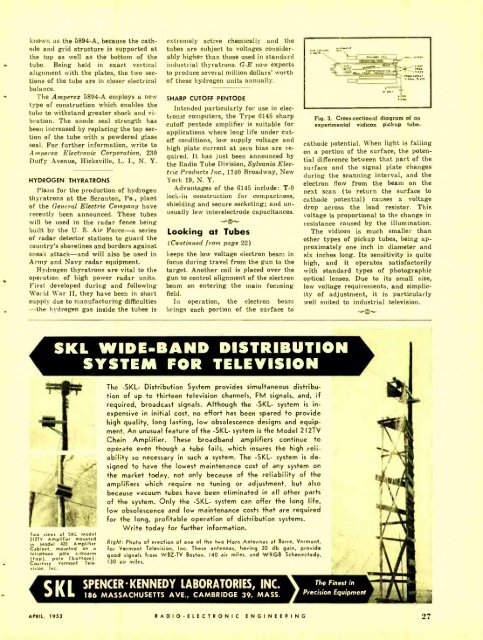T EVIS i - AmericanRadioHistory.Com
T EVIS i - AmericanRadioHistory.Com
T EVIS i - AmericanRadioHistory.Com
Create successful ePaper yourself
Turn your PDF publications into a flip-book with our unique Google optimized e-Paper software.
known as the 5894 -A, because the cathode<br />
and grid structure is supported at<br />
the top as well as the bottom of the<br />
tube. Being held in exact vertical<br />
alignment with the plates, the two sections<br />
of the tube are in closer electrical<br />
balance.<br />
The Amperex 5894 -A employs a new<br />
type of construction which enables the<br />
tube to withstand greater shock and vibration.<br />
The anode seal strength has<br />
been increased by replacing the top section<br />
of the tube with a powdered glass<br />
seal. For further information, write to<br />
A mperex Electronic Corporation, 230<br />
Duffy Avenue, Hicksville, L. I., N. Y.<br />
HYDROGEN THYRATRONS<br />
Plans for the production of hydrogen<br />
thyratrons at the Scranton, Pa., plant<br />
of the General Electric <strong>Com</strong>pany have<br />
recently been announced. These tubes<br />
will be used in the radar fence being<br />
built by the U. S. Air Force -a series<br />
of radar detector stations to guard the<br />
country's shorelines and borders against<br />
sneak attack -and will also be used in<br />
Army and Navy radar equipment.<br />
Hydrogen thyratrons are vital to the<br />
operation of high power radar units.<br />
First developed during and following<br />
World War II, they have been in short<br />
supply due to manufacturing difficulties<br />
-the hydrogen gas inside the tubes is<br />
extremely active chemically and the<br />
tubes are subject to voltages considerably<br />
higher than those used in standard<br />
industrial thyratrons. G -E now expect,<br />
to produce several million dollars' worth<br />
of these hydrogen units annually.<br />
SHARP CUTOFF PENTODE<br />
Intended particularly for use in electronic<br />
computers, the Type 6145 sharp<br />
cutoff pentode amplifier is suitable for<br />
applications where long life under cutoff<br />
conditions, low supply voltage and<br />
high plate current at zero bias are required.<br />
It has just been announced by<br />
the Radio Tube Division, Sylvania Electric<br />
Products Inc., 1740 Broadway, New<br />
York 19, N. Y.<br />
Advantages of the 6145 include: T -9<br />
lock -in construction for compactness,<br />
shielding and secure socketing; and unusually<br />
low interelectrode capacitances.<br />
Looking at Tubes<br />
(Continued from page 22)<br />
keeps the low voltage electron beam in<br />
focus during travel from the gun to the<br />
target. Another coil is placed over the<br />
gun to control alignment of the electron<br />
beam on entering the main focusing<br />
field.<br />
In operation, the electron beam<br />
brings each portion of the surface to<br />
Fig. 3. Cross -sectional diagram of an<br />
experimental vidicon pickup tube.<br />
cathode potential. When light is falling<br />
on a portion of the surface, the potential<br />
difference between that part of the<br />
surface and the signal plate changes<br />
during the scanning interval, and the<br />
electron flow from the beam on the<br />
next scan (to return the surface to<br />
cathode potential) causes a voltage<br />
drop across the load resistor. This<br />
voltage is proportional to the change in<br />
resistance caused by the illumination.<br />
The vidicon is much smaller than<br />
other types of pickup tubes, being approximately<br />
one inch in diameter and<br />
six inches long. Its sensitivity is quite<br />
high, and it operates satisfactorily<br />
with standard types of photographic<br />
optical lenses. Due to its small size,<br />
low voltage requirements, and simplicity<br />
of adjustment, it is particularly<br />
well suited to industrial television.<br />
SKL WIDE -BAND DISTRIBUTION<br />
SYSTEM FOR TEL<strong>EVIS</strong>ION<br />
Two views of SKL Model<br />
212TV Amplifier mounted<br />
in Model 420 Amplifier<br />
Cabinet, mounted on a<br />
telephone pole crossarm<br />
(top), pole<br />
(bottom).<br />
Courtesy Vermont Tele.<br />
vision, Inc.<br />
The -SKL- Distribution System provides simultaneous distribution<br />
of up to thirteen television channels, FM signals, and, if<br />
required, broadcast signals. Although the -SKL- system is inexpensive<br />
in initial cost, no effort has been spared to provide<br />
high quality, long lasting, low obsolescence designs and equipment.<br />
An unusual feature of the -SKL- system is the Model 212TV<br />
Chain Amplifier. These broadband amplifiers continue to<br />
operate even though a tube fails, which insures the high reliability<br />
so necessary in such a system. The -SKL- system is designed<br />
to have the lowest maintenance cost of any system on<br />
the market today, not only because of the reliability of the<br />
amplifiers which require no tuning or adjustment, but also<br />
because vacuum tubes have been eliminated in all other parts<br />
of the system. Only the -SKL- system can offer the long life,<br />
low obsolescence and low maintenance costs that are required<br />
for the long, profitable operation of distribution systems.<br />
Write today for further information.<br />
Right: Photo of erection of one of the two Horn Antennas at Barre. Vermont,<br />
for Vermont Television, Inc. These antennas, having 20 db gain, provide<br />
good signals from WBZ -TV Boston, 140 air miles, and WRGB Schenectady,<br />
130 air miles.<br />
vri<br />
-p<br />
S K L<br />
SPENCER KENNEDY LABORATORIES, INC<br />
186 MASSACHUSETTS AVE., CAMBRIDGE 39, MASS.<br />
The Finest in<br />
Precision Equipment<br />
APRIL, 1953<br />
R A D I O - E L E C T R O N I C E N G I N E E R I N G 27

















